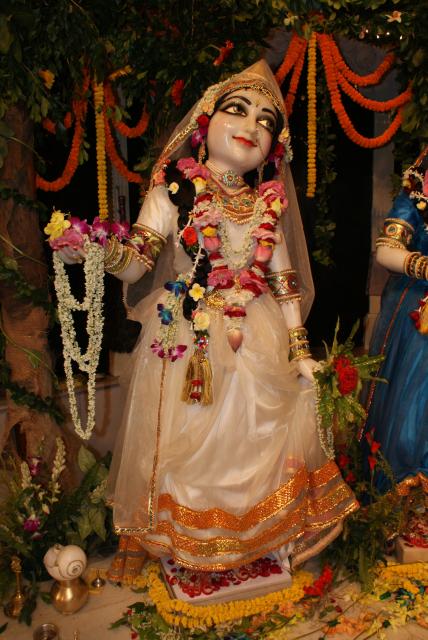
The gopi Tungavidya, who was most learned in all the scriptures, has today become the sannyasi Prabodhananda, whose words are all used in the glorification of Lord Gauranga. (In the image: Tungavidya Gopi, ISKCON Mayapur).
sa prabodhananda-yatir gaurodgana-sarasvati
The gopi Tungavidya, who was most learned in all the scriptures, has today become the sannyasi Prabodhananda, whose words are all used in the glorification of Lord Gauranga.
Venkata Bhatta lived in South India. He held a special position amongst the Brahmins as he was very learned in all the scriptures.
There was a Vaishnava of the Shri-sampradaya named Venkata Bhatta who respectfully invited the Lord to his house. (Chaitanya Charitamrita 2.9.82)
In his commentary to this verse of the Chaitanya-charitamrita, Shrila Bhaktivinoda Thakur has written: “Venkata Bhatta, Trimalla Bhatta and Prabodhananda Saraswati were previously acharyas of the Shri-sampradaya. Gopal Bhatta Goswami was the son of Venkata Bhatta.”
Shrila Bhaktisiddhanta Saraswati Goswami Thakur has also commented on the same verse: “Shri Venkata Bhatta was a Brahmin of the Shri-sampradaya who lived in Shrirangam. [FN: Shrirangam is situated on the Kaveri River near Trichinopoly. It is about ten miles from Kumbhakonam in the Tanjor district of Tamil Nadu. The Temple of Shri Ranganatha is the largest Temple in India.] Because Shrirangam is situated in Tamil Nadu, people no longer use the names Venkata and Tirumalai (Trimalla). This family had possibly moved to Shrirangam not long before Mahaprabhu’s visit there. Venkata Bhatta belonged to the Variagalai branch of the Ramanuja sampradaya. One of his brothers was the tridandi sannyasi, Prabodhananda, who acted as an acharya of the school. Venkata Bhatta’s son was Gopal Bhatta Goswami.”
Previously, these three brothers were worshipers of Lakshmi Narayan, but they were converted to the worship of Radha and Krishna by the grace of Shri Chaitanya Mahaprabhu. Krishnadas Kaviraj Goswami has described this conversion in his Chaitanya Charitamrita.
Shrila Prabodhananda Saraswati’s disciple was his own nephew, Gopal Bhatta, one of the six Goswamis.
bhakter vilasamsh cinute prabodha-
nandasya shishyo bhagavat-priyasya
gopala-bhatto raghunatha-dasam
santoshayan rupa-sanatanau ca
Gopal Bhatta, the disciple of Prabodhananda who is dear to the Lord, has compiled these devotional activities to satisfy Raghunath Das, Rupa and Sanatan Goswamis. (Hbv 1.2)
Shrila Prabodhananda Saraswati wrote a number of books, including Vrindavan-shataka, Navadwip-shataka, Radha-rasa-sudhanidhi, Chaitanya-chandramrita, which are especially loved by rasika Devotees. Some of his other titles are Sangita-Madhava, Ashcharya-rasa-prabandha, Shruti-stuti-vyakhya, Gitagovinda-vyakhyana and Kama-bija-kama-gayatri-vyakhyana.
Is Prabodhananda Prakashananda?
In the third chapter of the Madhya-khanda of the Chaitanya Bhagavat, Shrila Bhaktisiddhanta Saraswati Goswami Thakur comments as follows: “Prakashananda was a teacher of the mayavada doctrine and a sannyasi. While discoursing on the Veda, he cuts up my divine and transcendental body into pieces. Some inexperienced people say that this Prakashananda is the same person as the Prabodhananda, the younger brother of Venkata Bhatta who lived on the banks of the Kaveri. This error has entered into the sahajiya book named Bhaktamal, and the same erroneous belief has entered into the writings of many modern scholars also.” (Gaudiya-bhashya, Madhya-khanda, 3.37.)
That which Shrila Bhaktisiddhanta Saraswati Goswami Thakur has indicated in this commentary is quite true. Ashutosh Deb has written in his dictionary under the rubric, Prabodhananda Saraswati, “A Vaishnava philosopher whose real name was Prakashananda Saraswati. Chaitanya Deva gave him the name Prabodhananda.”
Hari Das Das has also written in his Gaudiya Vaishnava Abhidhana: “Some people hold that Prabodhananda is the Vaishnava name given to Prakashananda… It is clear from the last verse of the Radha-rasa-sudha-nidhi that Prabodhananda had at one time been a mayavadi sannyasi.”
We would argue that the words mayavadarka-tapa-santapta which Hari Das Das quotes as proof of Prabodhananda’s former adherence to the impersonalist philosophy are not acceptable as proof. Mahaprabhu and all of His followers argued against the impersonalist doctrines as much as they could because of its extreme opposition to devotion. The Lord’s deliverance of Sarvabhauma Bhattacharya and Prakashananda Saraswati are greater feats of mercy than even the salvation of Jagai and Madhai. This statement in the Rasa-sudha-nidhi is simply an effort to show the extent of Mahaprabhu’s mercy and His quality as the deliverer of the most fallen.
Saraswati Thakur’s Introduction to Chaitanya-chandramrita
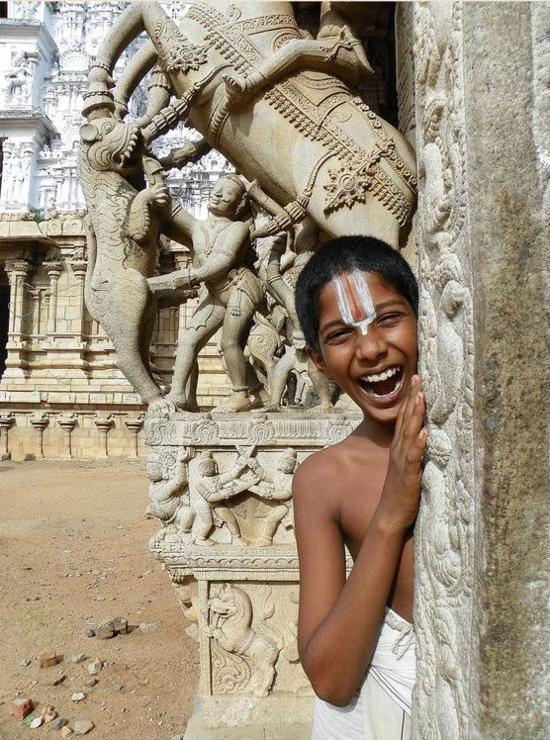
In 1510 AD, Shri Krishna Chaitanya went to Southern India in order to show His mercy to His Devotees, though His ostensible purpose was to perform a pilgrimage. Starting from Puri in Orissa, He traveled southward to the Godavari and then continued through various other holy places. On the Ekadashi of the waxing fortnight of the month of Asharih, Mahaprabhu found Himself in Shrirangam. The monks of the Dashanami order to which Mahaprabhu belonged normally follow the Chaturmasya vows, and so the Lord decided to spend the four-month period in Shrirangam. This town is the residence of many Vaishnavas of the Shri-sampradaya. (In the image: Shrirangam basi-resident, Tamil Nadu).
In his introduction to the edition of Chaitanya-chandramrita, Shrila Bhaktisiddhanta Saraswati Goswami Thakur, the founder of the worldwide Chaitanya Maths has written an account of Prabodhananda Saraswati’s life. The rest of this chapter is a quotation in full of this account:
In 1510 AD, Shri Krishna Chaitanya went to Southern India in order to show His mercy to His Devotees, though His ostensible purpose was to perform a pilgrimage. Starting from Puri in Orissa, He traveled southward to the Godavari and then continued through various other holy places. On the Ekadashi of the waxing fortnight of the month of Asharih, Mahaprabhu found Himself in Shrirangam. The monks of the Dashanami order to which Mahaprabhu belonged normally follow the Chaturmasya vows, and so the Lord decided to spend the four-month period in Shrirangam. This town is the residence of many Vaishnavas of the Shri-sampradaya.
The Vaishnavas of this school are strongly fixed in their practice. Throughout southern India, Smarta Brahmins find it difficult to live in villages where the Shri Vaishnavas are strong. In that period, Shrirangam was a holy place exclusively inhabited by the Shri Vaishnavas. Mahaprabhu considered this a favorable environment for the execution of His four-month vow and so He spent the period in visiting the Temple of Ranganatha and preaching about Krishna.
Three brothers, Tirumalaya, Venkata and Gopalguru had recently come from Mysore to live in Shrirangam. They were not Tamils but Andhras or from Uttarapradesha. The Lord was particularly merciful to this Brahmin family and spent the four months of the rainy season in their house. The middle brother, Venkata, had a son of five years who later became Gopal Bhatta Goswami, one of the six Goswamis.
The Vaishnavas of the Shri-sampradaya are devoted to the worship of Lakshmi Narayan. By Mahaprabhu’s blessings, this Bhatta family developed a taste for Krishna rasa. Although we know nothing more about Tirumalaya, we can surmise that he was totally devoted to Shri Chaitanya Mahaprabhu. The Lord’s conversation with Venkata Bhatta is described in the ninth chapter of the Chaitanya Charitamrita’s Madhya-lila.
Prabodhananda was unequalled in his attachment to Shri Chaitanya. Through his pure teachings, Venkata’s son Gopal Bhatta became a great acharya of the Gaudiya Vaishnava school. Prabodhananda himself has a particularly elevated position amongst the followers of Shri Chaitanya. Kavi Karnapura has identified him as Tungavidya in his Gaura-ganoddesha-dipika. In the Hari-bhakti-vilasa, he is identified as Gopal Bhatta Goswami’s guru and as extremely dear to Lord Chaitanya. In the Bhakti-ratnakara, the following passages about him are found: Some people glorified Prabodhananda’s virtues and thus he was given the title Saraswati by which he was known everywhere. Shri Krishna Chaitanya is the Supreme Lord and Supreme Absolute Truth. He was so dear to Prabodhananda that even in his dreams he knew nothing else. Prabodhananda was greatly renounced; he was affection incarnate and handsome, as well as being a great poet and expert in singing, playing musical instruments and dance. Everyone’s joy increased on hearing him speak. These are some of the unlimited glories of Prabodhananda Saraswati. (Bhakti-ratnakara 1.149-153)
Prabodhananda Comes to Live in Vraja
A few years after Mahaprabhu had returned to Puri, Prabodhananda entered into a deep understanding of the most intimate teachings given by Chaitanya Mahaprabhu. He left Shrirangam and went to live in Kamyavana in the Mathura region. Gopal Bhatta also gradually developed an intense desire to come and live in Vraja and so he followed the path taken by his uncle and guru.
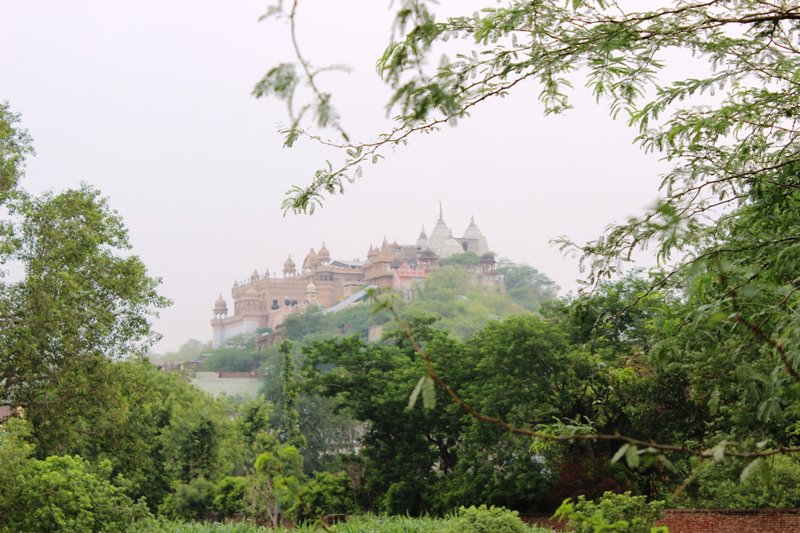
A few years after Mahaprabhu had returned to Puri, Prabodhananda entered into a deep understanding of the most intimate teachings given by Chaitanya Mahaprabhu. He left Shrirangam and went to live in Kamyavana in the Mathura region. Gopal Bhatta also gradually developed an intense desire to come and live in Vraja and so he followed the path taken by his uncle and guru. (In the image: ManMandir, Varshana, Uttar Pradesh).
Many people ask the question, “If Prabodhananda was so dear to Chaitanya, why is his name not mentioned anywhere in the Krishnadas Kaviraj Goswami’s Chaitanya Charitamrita? Would he not have included the pastimes of such a great personality for the pleasure of the Vaishnavas?” We can find an adequate response to this question in the Bhakti-ratnakara. Narahari Chakravarti writes:
Some people have described these activities of Gopal Bhatta, others have not. Those who cannot understand the reason for this engage in useless argument, with the result that an offensive attitude takes root in them. Previously, great rasika Devotee poets who were quite capable of describing these events did not do so in order that others would be able to do so in the future. Gopal Bhatta enthusiastically gave his approval to the writing of [Chaitanya-caritamrita] but would not allow [Krishnadas] to write anything about him. Who knows why he did this; likely it was his great humility. Krishnadas Kaviraj Goswami was not able to ignore his command. (Bhakti-ratnakara 1.209…223)
Prabodhananda and svakiya-rasa
Some people say that Prabodhananda’s writing show a tendency to the svakiya doctrine. For this reason, Gaudiya Vaishnavas who consider the parakiya-vada superior do not show a great enthusiasm for studying his books. Anyone who is devoted to Chaitanya Mahaprabhu is blessed. We simply follow Narahari Chakravarti, a neutral commentator, and avoid useless argument. We relish the writings of Prabodhananda which are filled with the sweetness of servitude to Krishna in the parakiya mood.
Prabodhananda’s mood is very clear. In his language, both gravity and sweetness are found equally. Mahaprabhu’s Devotees take great pleasure in reading his Vrindavan-shataka. His Navadwip-shataka resembles the Vrindavan-shataka. His Radha-rasa-sudha-nidhi is truly unequalled in the entire world. This book, Chaitanya-charitamrita, does not bring quite the same degree of pleasure from the poetic point of view, but is nevertheless extremely dear to the Devotees who have an attachment to the sacred rapture of devotion. According to one’s taste, one experiences a work as being superior or inferior. Thus for the transcendental moods of Vraja-bhakti to take effect on a reader, there is a certain dependence on his pious activities from previous lives. Another book, Viveka-shataka, attested by Aufrecht in his notices of manuscripts, is attributed to Prabodhananda Saraswati. The late Rama Das Sena of Berhampore saw this manuscript.
The Chaitanya-charitamrita was widely distributed in Bengal. Even those inimical to Chaitanya became purified upon reading it and experienced a change of heart. It thus goes without saying that Devotees of Lord Chaitanya Mahaprabhu will be immersed in an ocean of indescribable ecstasy. When the Lord of Goloka comes and stays for four months in someone’s house and accepts service from that household, it is not surprising that He bestows upon that household the most rare forms of love of God. The insignificant living entities can hope to gain some crumbs from the storehouse of priceless love which these blessed persons possess.
Prakashananda Saraswati
Some people attempt to identify Prabodhananda with the Mayavadi sannyasi Prakashananda Saraswati who lived in Varanasi. We are not able to accept their arguments in any way whatsoever for the following reasons: The following account of Prakashananda Saraswati is given in the third chapter of the Madhya-khanda in the Chaitanya Bhagavat:
"Thus the Lord constantly floated in the joys of devotion along with His followers in Navadwip. One day, He heard a verse glorifying the Varaha avatar. He began to roar and went to Murari Gupta’s house. Being satisfied by the praises of Murari, He began to speak in anger against the Vedas: “The Vedas say that I have no hands, feet, face or eyes. This is the way that they make a mockery of Me. In Kashi there is a rascal named Prakashananda who teaches people, cutting My body up into little pieces. He states that the Veda does not accept that I have a body. His entire body has become infected with leprosy and yet he still does not accept My transcendental form. My body is pure and the condensed form of all the sacrifices. Brahma, Shiva and the other gods all glorify My form and activities. What audacity this rascal has to say that My body is false when one accumulates merit and becomes purified by coming into contact with it." (Chaitanya Bhagavat 2.3.35-40)
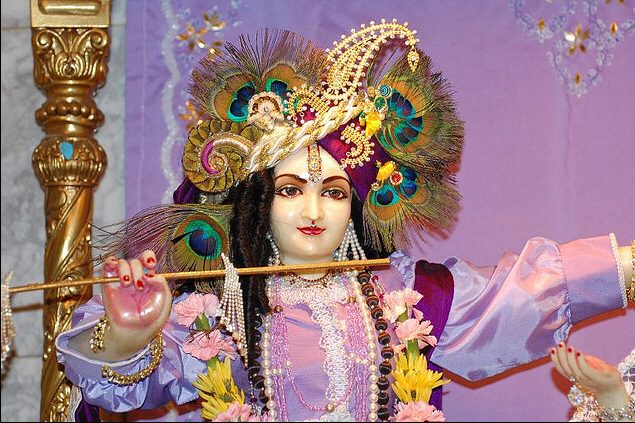
“The Vedas say that I have no hands, feet, face or eyes. This is the way that they make a mockery of Me. In Kashi there is a rascal named Prakashananda who teaches people, cutting My body up into little pieces. He states that the Veda does not accept that I have a body. His entire body has become infected with leprosy and yet he still does not accept My transcendental form. My body is pure and the condensed form of all the sacrifices. Brahma, Shiva and the other gods all glorify My form and activities. What audacity this rascal has to say that My body is false when one accumulates merit and becomes purified by coming into contact with it." (Chaitanya Bhagavat 2.3.35-40) (In the image: Shri Vrindavana Natabara, ISKCON Columbus, Ohio).
This event took place sometime between 1425 and 1430 of the Shaka era (1504 and 1509 AD). Mahaprabhu came to Shrirangam in 1433 (1512 AD) which is the first time that He met Prabodhananda and his brothers. The three brothers were Vaishnavas in the Shri sampradaya following Ramanuja and thus believers in the eternal form of Narayan. Prakashananda was a Mayavadi sannyasi during this time, a prominent follower of Shankara’s doctrine. It is sheer madness to say that that these two persons are one and the same. Again, in the Chaitanya Bhagavat, Madhya-khanda, the following mention is made of Prakashananda Saraswati:
As he spoke, the Lord was suddenly possessed by the spirit of the Divinity. Grinding His teeth, He angrily spoke the following words: The sannyasi Prakashananda is preaching in Kashi in a way that cuts My body into pieces. The rascal teaches Vedanta but does not accept My transcendental form. I have infected his body with leprosy, but still he does not understand. How can this rascal say that My body, which is filled with unlimited universes, is false? I tell you truthfully, Murari, for you are My servant, that anyone who denies My transcendental form is destined for destruction. My lila and My works are all true; My abode is true. Anyone who denies them will be struck down. The glories of the Lord will destroy one’s ignorance if one hears them, but this sinful professor calls it all false. Anyone who has so little affection for My holy fame will never be able to understand My incarnation. (Chaitanya Bhagavat 2.10.31…44)
At that time, Prakashananda Saraswati was the leader of the ekadandi sannyasi followers of Shankara, whereas Prabodhananda was a tridandi sannyasi in the line of Ramanuja, who had moved to Shrirangam from Mysore. Prakashananda was a Mayavadi living in Kashi, whereas Prabodhananda was a Vaishnava living in Kamyavana. One was a northerner, the other a southerner. One was an impersonalist and monist, the other a Devotee who first followed Ramanuja’s vishishtadvaita-vada and then converted to Mahaprabhu’s achintya-bhedabheda-vada. One was an enemy of Vishnu and the Vaishnavas and only after conversion became a Devotee, the other was the guru of Gopal Bhatta Goswami, an eternal associate of Lord Chaitanya Mahaprabhu and acharya of the Gaudiya Vaishnava sampradaya. Anyone who calls Gopal Bhatta Goswami’s worshipable guru and uncle a mayavadi and enemy of Vishnu and the Vaishnavas, a conditioned soul, rather than an eternally perfect Devotee of the highest order, is engaging in insults which are offensive and sure to lead him who makes them to a hellish destination.
In two places in the Chaitanya Charitamrita, an extensive description of the conversion of Prakashananda Saraswati is given. It is impossible to understand how someone who had been a mayavadi from 1504 to 1509, then a qualified dualist Vaishnava in South India in 1512, should again become the leader of the Mayavadis in Kashi in 1514. Therefore, any attempt to identify Prakashananda with Prabodhananda is evidence of extreme ignorance. It is no small cause of distress to see the tradition being uprooted in this way. As proof of his humility, Prabodhananda asked through Gopal Bhatta that his own activities not be described in the Chaitanya-charitamrita. Krishnadas Kaviraj Goswami was not able to disobey this order and so today we have this problem. If Prabodhananda had known that as a result of this silence people would later fall into confusion and identify him with someone who preached against Vishnu and the Vaishnavas he would surely not have commanded Gopal Bhatta and Krishnadas Kaviraj in this way. Anyone who reads the Bhakti-ratnakara will understand. The author of that book writes:
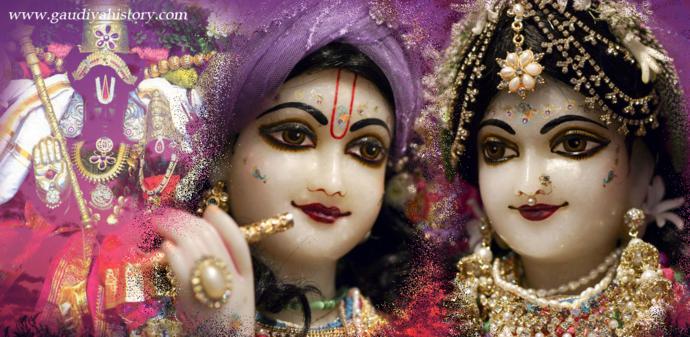
Gaurachandra was the wealth of Tirumalaya, Venkata and Prabodhananda’s lives. The three of them were worshipers of Lakshmi Narayan whose preferences changed to Radha and Krishna as a result of the Lord’s mercy...(In the wallpaper: from left to right Shri Shri Lakshmi Narayana Pirumala, Shri Shri Radha Gopinatha, Radhadesh, ISKCON Belgium).
Gaurachandra was the wealth of Tirumalaya, Venkata and Prabodhananda’s lives. The three of them were worshipers of Lakshmi Narayan whose preferences changed to Radha and Krishna as a result of the Lord’s mercy… The three of them wondered how they could continue living in the Lord’s absence; they wondered who would joke with them and who would accompany them to the Kaveri to bathe in the morning… After four months, when the Lord left, the three brothers began to cry. Mahaprabhu embraced the three brothers and tried to console them. Some people glorified Prabodhananda’s virtues and thus he was given the title Saraswati by which he was known everywhere. Shri Krishna Chaitanya is the Supreme Lord and Supreme Absolute Truth. He was so dear to Prabodhananda that even in his dreams he knew nothing else. (Bhakti-ratnakara 1.83-4, 128-9, 133, 135, 149, 150)
Professor Aufrecht has listed Sangita-Madhava as Prabodhananda’s work. We managed to trace this work and published it in the 18th volume of Sajjana-toshani, in issues 5-12.
Shri Vaishnavas who renounce family life never take the single staff (ekadanda), which is the mark of the Shankarites. Their custom is to take the triple staff (tridanda) and the title Ramanujaryaswami. Some people claim upon reading the Chaitanya-charitamrita that Prabodhananda had been a worshiper of Brahman, but if we accept this without any supplementary evidence we fall into difficulty.
[Excerpted from “Shri Chaitanya: His Life & Associates” by Shrila Bhakti Ballabh Tirtha Maharaj]

The sannyasi Prakashananda is preaching in Kashi in a way that cuts My body into pieces. The rascal teaches Vedanta but does not accept My transcendental form. I have infected his body with leprosy, but still he does not understand. How can this rascal say that My body, which is filled with unlimited universes, is false? I tell you truthfully, Murari, for you are My servant, that anyone who denies My transcendental form is destined for destruction. My lila and My works are all true; My abode is true. Anyone who denies them will be struck down. The glories of the Lord will destroy one’s ignorance if one hears them, but this sinful professor calls it all false. Anyone who has so little affection for My holy fame will never be able to understand My incarnation. (Chaitanya Bhagavat 2.10.31...44) (In the wallpaper: Supreme Personality of Godhead Krishna).





